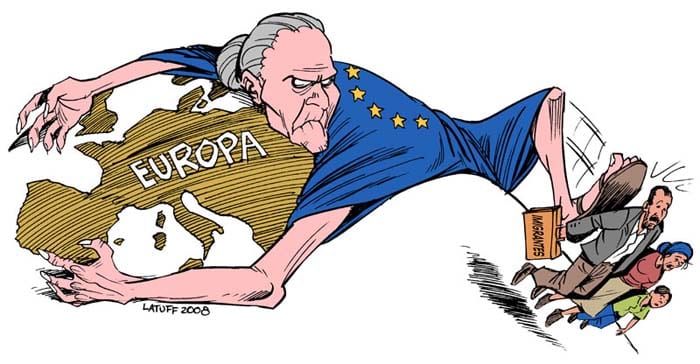
Updated Oct, 2023
Denmark’s Firm Stance on Asylum Seekers
Amid the global ebb and flow of migration, Denmark has taken a resolute stand on asylum seekers, employing a distinctive approach to convey its message. In a move that reverberated through Lebanese newspapers, Denmark placed adverts cautioning potential migrants about new and stringent regulations governing asylum in the country. Appearing in both Arabic and English publications, these adverts underscore the Danish government’s commitment to tightening regulations in specific areas.
The advertisements emphasize critical changes, prominently stating, ‘Denmark has decided to tighten the regulations concerning refugees in some areas.’ The messaging is direct, outlining a reduction of social benefits for newly-arrived refugees by ‘up to 50 per cent.’ This financial adjustment, coupled with restrictions on family reunification for those with temporary residence permits during their first year, paints a clear picture of Denmark’s evolving approach to asylum policies.
Crucially, the adverts articulate a shift in language requirements for obtaining permanent residency, signaling that prospective migrants must speak and understand Danish. This linguistic criterion adds a layer of integration expectations, emphasizing the importance of language proficiency in securing a lasting place in Danish society.
The message continues with a stern directive, stating, ‘All rejected asylum seekers must be returned quickly from Denmark.’ This declaration is coupled with the establishment of a dedicated return center, underscoring the government’s commitment to swift deportations for those whose asylum requests are denied. The expeditious nature of the process aims to ensure that rejected asylum seekers ‘leave Denmark as quickly as possible.’
The Danish government’s proactive measures, as conveyed through these advertisements, represent a calculated response to the complex challenges associated with the global migration landscape. Asylum seekers, contemplating Denmark as a potential destination are met with a comprehensive overview of the evolving policies that govern their stay. The transparency in communication serves not only as a deterrent but also as a foundation for informed decision-making among those considering Denmark as a destination.
The advertisements, strategically placed in Lebanese newspapers, reflect Denmark’s recognition of the need for targeted communication to specific migrant populations. By addressing potential migrants directly and transparently, Denmark seeks to manage expectations and convey the evolving reality of asylum policies within its borders.
In the broader context of Europe’s response to migration, Denmark’s firm stance represents one wave in a series of shifts occurring across the continent. The complexities of migration policies, integration expectations, and the clash of civilizations are part of a larger narrative unfolding in Europe. As each wave of policy changes takes shape, it introduces new dynamics and challenges, reflecting the evolving nature of the global migration discourse.
The clash of civilizations, alluded to in the context of Denmark’s evolving stance, underscores the deep-rooted societal and cultural implications associated with migration policies. While Denmark’s approach is grounded in addressing immediate concerns, the broader impact on societal harmony and global perceptions remains a nuanced and ongoing dialogue.
In navigating the multifaceted terrain of migration, Denmark’s actions contribute to the evolving narrative of how nations address the complexities of asylum, integration, and societal coexistence. The clash of civilizations, as described, is a complex interplay that requires continual examination and understanding as it shapes the future trajectory of migration policies in Denmark and beyond.
Russia’s Military Technological Advancements
In the ever-evolving landscape of military technology, Russia continues to assert its prowess with the development of an advanced high-speed combat helicopter, known as the PSV. While reports surfaced earlier about the helicopter’s existence, details regarding its specific capabilities were unveiled by Grigory Kozlov, the deputy CEO for sales at Russian Helicopters company.
The PSV, anticipated to enter commercial production by 2022, represents a significant leap in combat helicopter technology. Commander-in-Chief of the Russian Air Force, Viktor Bondarev, revealed that the PSV can achieve speeds of up to 500 kilometers (311 miles) per hour. This capability positions the helicopter as a formidable asset for various military applications, whether offensive operations or tactical transportation.
Kozlov provided insight into the broader landscape of helicopter development in Russia, highlighting ongoing projects such as the Mi-28NM, Ka-52K, and Mi-26T2. Alongside these initiatives, the commencement of work on the advanced high-speed combat helicopter underscores Russia’s commitment to maintaining a cutting-edge military arsenal. The Russian Helicopters company, a key player in this arena, was founded in 2007 and has since become a pivotal design and manufacturing entity, comprising five chopper plants, two design departments, production and maintenance enterprises, a repair plant, and a service company providing technical support.
The development of the PSV aligns with Russian President Vladimir Putin’s strategic vision of elevating Russia to the forefront of global military powers. The pursuit of advanced weaponry, characterized by cutting-edge capabilities, is a testament to Russia’s dedication to bolstering its military strength. The PSV, with its impressive speed and likely multifunctional applications, symbolizes the nation’s commitment to staying at the forefront of military innovation.
This technological advancement is not isolated; it echoes Russia’s broader efforts to showcase military superiority. The T-14 Armata main battle tank, unveiled earlier, stands as a formidable testament to Russia’s ambitions. Manufactured by Uralvagonzavod, the tank claims to be invisible to enemy radars, marking a significant leap in stealth technology. While the veracity of this claim may be subject to scrutiny, what remains undisputed is Russia’s pursuit of military capabilities that challenge existing norms.
The global implications of Russia’s military advancements cannot be overstated. The PSV and the T-14 Armata signify a paradigm shift, challenging the dominance traditionally associated with military powerhouses. Russia, under President Putin’s strategic direction, is positioning itself as a formidable force capable of rivaling any adversary. The notion that the U.S. is helpless against certain aspects of Russia’s military hardware introduces a new dynamic to the global geopolitical landscape.
Contrary to engagements with other nations, the U.S. faces a unique challenge in dealing with Russia’s military capabilities. The scale and sophistication of Russia’s weaponry, as showcased by the PSV and the T-14 Armata, require a strategic recalibration. The days of one-sided conflicts, as witnessed in previous engagements, are no longer applicable. Russia’s ability to retaliate and defend itself against any potential aggression reshapes the calculus of global power dynamics.
As the clash of civilizations unfolds in the realm of military technology, the narrative becomes increasingly complex. Russia’s determination to be a real threat and challenge to the U.S. underscores the evolving nature of geopolitical rivalries. The cautionary note that Russia is not Libya, Iraq, Syria, or Afghanistan serves as a stark reminder that engaging with Russia requires a nuanced understanding of its capabilities and a recalibration of traditional approaches to conflict.
In this unfolding narrative, the PSV and the T-14 Armata represent more than technological achievements; they symbolize a shift in the balance of military power and a redefinition of global security dynamics. The U.S. is confronted not just with military hardware but with a strategic adversary capable of reshaping the contours of geopolitical influence. As both nations navigate this complex landscape, the implications extend beyond individual conflicts, influencing the broader trajectory of international relations and the delicate balance of power on the world stage.
Hungary’s Migrant Crisis and the Unraveling of Policies
As the migrant crisis intensified in Hungary, scenes of defiance and determination unfolded on the streets of Budapest. Thousands of migrants, including Syrian refugees, embarked on a journey westward, marching down the main highway to Vienna, signaling a profound challenge to Hungary’s right-wing government and its attempts to enforce stringent immigration policies.
The Hungarian government, facing overwhelming numbers and safety concerns, conceded to the sheer will of the migrants. Approximately 100 buses were deployed to transport those camped in front of Budapest’s main railway terminus, while another 1,200, led by a one-legged Syrian refugee, made their way towards Vienna, chanting “Germany, Germany!” This turn of events marked a significant departure from Hungary’s earlier stance, which included canceled trains, confrontations with riot police, and a refusal to allow migrants to proceed.
Austria, in a collaborative move with Germany, announced that the migrants would be granted entry, bypassing European Union rules. The Austrian Chancellor, Werner Faymann, addressed the emergency situation on the Hungarian border, stating, “Because of today’s emergency situation on the Hungarian border, Austria and Germany agree in this case to a continuation of the refugees’ journey into their countries.” The agreement underscored a departure from established EU protocols, emphasizing the urgency of the situation.
The smiles on the faces of migrants boarding the buses painted a picture of relief and hope. Hungarian volunteers and aid workers bid them farewell, acknowledging the unprecedented turn of events. The admission by Hungary’s government that it had lost control highlighted the magnitude of the crisis and the determination of migrants to forge ahead to wealthier and more generous countries in northern and western Europe, particularly Germany.
The surge in numbers, the defiance of EU rules, and the resolve of the migrants demonstrated a clash between policy enforcement and human desperation. Hungary’s earlier cancellations of trains, citing the obligation to register asylum seekers under EU rules, had resulted in a tense standoff. The decision to let buses carry migrants to Austria marked a critical juncture, emphasizing the government’s inability to contain the situation.
As migrants broke away from the Budapest train station and streamed through the capital, over bridges, and onto the main highway, the clash between governmental authority and the collective will of the people became palpable. The breaking of police barricades, the sprinting down railway tracks, and the confrontations at overcrowded border camps near Serbia encapsulated the escalating tensions and frustrations on both sides.
In the broader context, the comments below the story revealed a global ideological divide, mirroring the sentiments of “if you are not like me, you are against me.” The prediction of a massive war in Europe reflected the deep-seated concerns about cultural clashes and societal eruptions. The characterization of Syrians as open-minded Muslims contrasted with the perceived closed-mindedness of native Europeans, pointing towards a narrative of cultural resistance and potential conflict.
The months and years to come may witness the eruption of complex societal dynamics in Europe. The collision of values, cultural identities, and government policies underscores the multifaceted nature of the migrant crisis. As events unfold, the reactions of native populations, governments, and migrants will shape the trajectory of Europe’s response to one of the most challenging humanitarian crises of the 21st century. The clashes on the streets of Budapest are symbolic of a larger struggle for coexistence and understanding in a world grappling with the complexities of mass migration and cultural diversity.
Words that Leave an Impression: Captivating Articles

Third Wave Feminism Criticism: Valid Points Amidst the Debate

Mastering the Art of Retirement: How to Start Saving for Retirement at 45 with Grace and Style

Third Wave Feminism is Toxic: Its Impact on America

Investor Sentiment in the Stock Market: Maximizing Its Use

What is the Average Student Loan Debt in the US? Understanding the Crisis

Student Debt Crisis Solutions: Halting the Madness is Essential

Financial Freedom Reverse Mortgage: A Sophisticated Strategy for a Comfortable Retirement

Early Retirement Extreme: A Philosophical and Practical Guide to Financial Independence

Student Loan Refinance: A Smart Move Towards Financial Freedom – Poise in Debt Reduction

How to Lose Money: The Dangers of Ignoring Market Trends and Psychology in Stock Investing

How much has the stock market gone up in 2023? -A Refined Analysis

Maximizing Gains: Mastering Market Sentiment Indicators

How to Achieve Financial Goals: The Midas Touch for Your Financial Dreams

Sophisticated Strategies for US Dollar Index Investing: Elevate Your Forex Game



